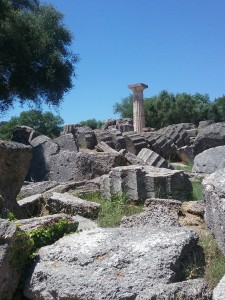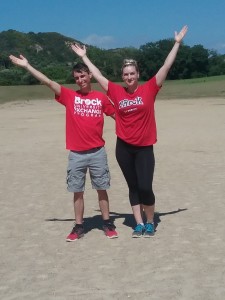Few people have the opportunity to ever visit the ancient site of Olympia, fewer still have the chance to run with their peers on the very track were the first Olympics took place in 776 BCE.
The Temple of Hera was the first stop on our site tour of Olympia. To read of and view pictures is nothing like standing in front of temple ruins and visualizing what stands before you as it was in the 6th century BCE. Looking at the remaining columns that were originally wooden and then replaced, the Doric temple comes alive.
Built as the first temple at Olympia perhaps originally to honour Zeus, it would become the Temple of Hera to honour the womens’ quarterly games. To see the stone columns drums that remain, the size and visual detail in the stonework in relation to the other buildings and how it was situated within the site plan alone was so much more than you can get from a book. Will’s informative talk and the digital reconstruction photo that he provided made it possible to truly visualize the magnificence of the Temple.
Directly east of the Temple of Hera is the site of the nymphaion. The expansive width of remaining blocks of black stone and the intricate detail on them provides an indication of the massive size of the fountain. After a visit to the museum housing so many of the archaeological finds, the grandeur of the fountain materializes once you see the schematic of the basin sizes, the lion’s head spouts and the statues that were housed in a two tiered pavilion at the back.
The most impressive temple area is the Temple of Zeus. Standing next to the tumbled column drums is something that is indescribable. It isn’t until then that the full scope of the enormity is seen. The area looks like toppled dominos belonging to a giant. The Temple of Zeus would have been breathtaking. The whole site must have been made one breathless with its beauty.
A highlight of my day was Charles’ presention on Pheidias. As we stood within the great sculptor’s workshop you could envision the activity, training and skill that the space once housed. At each site we have visited what has been foremost in my thoughts is the training and skill required to design and sculpt these great masterpieces and the sheer number of works.
The visit afterwards to the Olympia Museum and the exquisite treasures was so wonderful. The warrior helmets and armour, the votive offerings, and the sculptures were all there. The visit was overwhelming in many ways on account of the extent of the site itself and the quantity of the museum’s artifacts. How does one take in centuries of history in an afternoon? It is some place to visit again.
What would it be without a footrace in the very footsteps of Greece’s earliest Olympians? The Brock Olympians strode through the secret entrance mentioned by Pausanias to the cheers of spectators lining the gentle slopes of the stadium. In view of the altar for Demeter Chamyne on the north embankment, the runners lined up behind the ancient stone threshold. Behold the victors! The Brock Odyssey continues.






